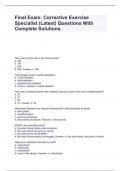Wolffs law describes what - Study guides, Class notes & Summaries
Looking for the best study guides, study notes and summaries about Wolffs law describes what? On this page you'll find 54 study documents about Wolffs law describes what.
Page 3 out of 54 results
Sort by
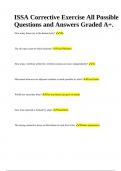
-
ISSA Corrective Exercise All Possible Questions and Answers Graded A+.
- Exam (elaborations) • 38 pages • 2023
-
- $11.99
- + learn more
ISSA Corrective Exercise All Possible Questions and Answers Graded A+. How many bones are in the human body? 206 The rib cage is part of which skeleton? Axial Skeleton How many vertebrae within the vertebral column can move independently? 24 Movement between two adjacent vertebrae is made possible by what? Facet Joints Wolffs law describes what? The way bones can grow or shrink New bone material is formed by what? Osteoblasts The strong connective tissue on the bottom of each foot is the:...
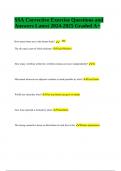
-
SSA Corrective Exercise Questions and Answers Latest 2024-2025 Graded A+.
- Exam (elaborations) • 41 pages • 2024
-
- $13.49
- + learn more
SSA Corrective Exercise Questions and Answers Latest Graded A+. How many bones are in the human body? 206 The rib cage is part of which skeleton? Axial Skeleton How many vertebrae within the vertebral column can move independently? 24 Movement between two adjacent vertebrae is made possible by what? Facet Joints Wolffs law describes what? The way bones can grow or shrink New bone material is formed by what? Osteoblasts The strong connective tissue on the bottom of each foot is the: Plant...
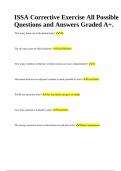
-
ISSA Corrective Exercise All Possible Questions and Answers Graded A+.
- Exam (elaborations) • 38 pages • 2023
-
- $12.99
- + learn more
ISSA Corrective Exercise All Possible Questions and Answers Graded A+. How many bones are in the human body? 206 The rib cage is part of which skeleton? Axial Skeleton How many vertebrae within the vertebral column can move independently? 24 Movement between two adjacent vertebrae is made possible by what? Facet Joints Wolffs law describes what? The way bones can grow or shrink New bone material is formed by what? Osteoblasts The strong connective tissue on the bottom of each foot is the:...

-
ISSA Corrective Exercise Questions and Answers Graded A
- Exam (elaborations) • 38 pages • 2023
- Available in package deal
-
- $14.99
- + learn more
How many bones are in the human body? 206 The rib cage is part of which skeleton? Axial Skeleton How many vertebrae within the vertebral column can move independently? 24 Movement between two adjacent vertebrae is made possible by what? Facet Joints Wolffs law describes what? The way bones can grow or shrink New bone material is formed by what? Osteoblasts
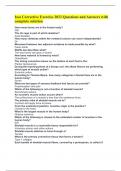
-
Issa Corrective Exercise 2023 Questions and Answers with complete solution
- Exam (elaborations) • 15 pages • 2023
-
- $12.49
- + learn more
Issa Corrective Exercise 2023 Questions and Answers with complete solution How many bones are in the human body? 206 The rib cage is part of which skeleton? Axial Skeleton How many vertebrae within the vertebral column can move independently? 24 Movement between two adjacent vertebrae is made possible by what? Facet Joints Wolffs law describes what? The way bones can grow or shrink New bone material is formed by what? Osteoblasts The strong connective tissue on the bottom of each ...
Final Exam: Corrective Exercise Specialist (Latest) Questions With Complete Solutions.
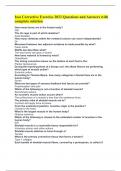
-
Issa Corrective Exercise 2023 Questions and Answers with complete solution
- Exam (elaborations) • 15 pages • 2023
-
- $14.29
- + learn more
Issa Corrective Exercise 2023 Questions and Answers with complete solution How many bones are in the human body? 206 The rib cage is part of which skeleton? Axial Skeleton How many vertebrae within the vertebral column can move independently? 24 Movement between two adjacent vertebrae is made possible by what? Facet Joints Wolffs law describes what? The way bones can grow or shrink New bone material is formed by what? Osteoblasts The strong connective tissue on the bottom of each ...
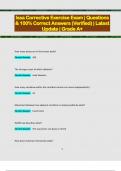
-
Issa Corrective Exercise Exam | Questions & 100% Correct Answers (Verified) | Latest Update | Grade A+
- Exam (elaborations) • 40 pages • 2024
-
- $14.99
- + learn more
How many bones are in the human body? Correct Answer: 206 The rib cage is part of which skeleton? Correct Answer: Axial Skeleton How many vertebrae within the vertebral column can move independently? Correct Answer: 24 Movement between two adjacent vertebrae is made possible by what? Correct Answer: Facet Joints Wolffs law describes what? Correct Answer: The way bones can grow or shrink New bone material is formed by what? 2 Correct Answer: Osteoblasts The strong connective tissue o...
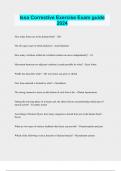
-
Issa Corrective Exercise Exam guide 2024
- Exam (elaborations) • 23 pages • 2024
-
- $12.49
- + learn more
How many bones are in the human body? - 206 The rib cage is part of which skeleton? - Axial Skeleton How many vertebrae within the vertebral column can move independently? - 24 Movement between two adjacent vertebrae is made possible by what? - Facet Joints Wolffs law describes what? - The way bones can grow or shrink New bone material is formed by what? - Osteoblasts The strong connective tissue on the bottom of each foot is the: - Plantar Aponeurosis During the lowering ph...
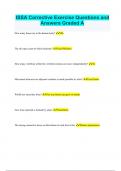
-
ISSA Corrective Exercise Questions and Answers Graded A.
- Exam (elaborations) • 38 pages • 2023
- Available in package deal
-
- $9.99
- + learn more
ISSA Corrective Exercise Questions and Answers Graded A. How many bones are in the human body? 206 The rib cage is part of which skeleton? Axial Skeleton How many vertebrae within the vertebral column can move independently? 24 Movement between two adjacent vertebrae is made possible by what? Facet Joints Wolffs law describes what? The way bones can grow or shrink New bone material is formed by what? Osteoblasts The strong connective tissue on the bottom of each foot is the: Plantar Apone...

How did he do that? By selling his study resources on Stuvia. Try it yourself! Discover all about earning on Stuvia



